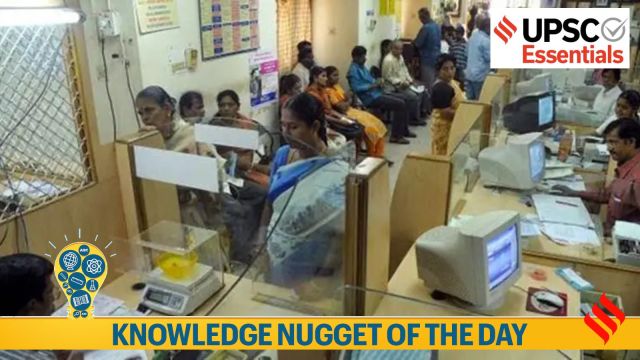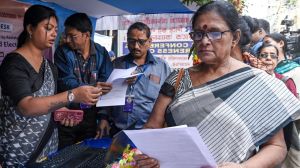
Why in the news?
Financial inclusion across the country improved to 67 in March 2025, up from 64.2 in March 2024, according to the recently released Financial Inclusion Index (FI-Index) by the Reserve Bank of India (RBI). “Improvement in FI-Index in FY2025 is contributed by usage and quality dimensions, reflecting deepening of financial inclusion, and sustained financial literacy initiatives,” the RBI said in a release.
Key Takeaways:
1. The FI-Index has been conceptualised as a comprehensive index incorporating details of banking, investments, insurance, postal as well as the pension sector in consultation with the government and respective sectoral regulators.
2. A unique feature of the index is the quality parameter which captures the quality aspect of financial inclusion as reflected by financial literacy, consumer protection, and inequalities and deficiencies in services.
3. The index captures information on various aspects of financial inclusion in a single value ranging between 0 and 100, where 0 represents complete financial exclusion and 100 indicates full financial inclusion.
4. The FI-Index comprises of three broad parameters: Access (having a weight of 35 per cent in the index), Usage (weight 45 per cent), and Quality ( weight 20 per cent). The weight of each parameter comprises various dimensions, which are calculated based on a number of indicators.
Story continues below this ad
5. The FI-Index has been constructed without any base year, and as such it reflects cumulative efforts of all stakeholders over the years towards financial inclusion. It is published annually in July every year.
Government flagship initiatives for financial inclusion
“Financial inclusion has been a key tool used by policymakers and governments globally to reduce inequalities, strengthen livelihoods of people at the bottom of the pyramid, and spur growth,” Soumya Kanti Ghosh wrote in the Indian Express.
📍Pradhan Mantri Jan Dhan Yojana (PMJDY): It was launched by Prime Minister Narendra Modi on August 28, 2014, with a mission of financial Inclusion to ensure access to financial services, namely, basic savings & deposit accounts, remittance, credit, insurance, pension in an affordable manner.
Under the PMJDY, there are no account opening charges, no account maintenance charges, and no minimum balance charges. Free RuPay debit card, with in-built accident insurance cover of Rs 2 lakh, and access to overdraft facility of up to Rs 10,000, are other major features of the scheme.
Story continues below this ad
 Progress of the Jan Dhan scheme.
Progress of the Jan Dhan scheme.
PMJDY accounts are eligible for Direct Benefit Transfer (DBT), Pradhan Mantri Jeevan Jyoti Bima Yojana (PMJJBY), Pradhan Mantri Suraksha Bima Yojana (PMSBY), Atal Pension Yojana (APY), Micro Units Development & Refinance Agency Bank (MUDRA) scheme.
📍Digital India: It was launched on July 1, 2015, by the Union Government with the vision to transform India into a digitally empowered society and knowledge economy. It comprises various initiatives under a single programme, each targeted to prepare India for becoming a knowledge economy and for bringing good governance to citizens through synchronised and coordinated engagement of the entire government.
Bharat Interface for Money (BHIM) App, Goods and Services Tax Network (GSTN), Pradhan Mantri Gramin Digital Saksharta Abhiyan (PMGDISHA), Aarogya Setu app, Digital India BHASHINI, and Open Network for Digital Commerce (ONDC) are some of the initiatives under the Digital India programme.
📍Pradhan Mantri Jeevan Jyoti Bima Yojana (PMJJBY): It is a one-year life insurance Scheme renewable from year to year. It offers coverage of Rs. Two lacs for death due to any reason and is available to people in the age group of 18 to 50 years having a bank account.
Story continues below this ad
The Department of Financial Services (DFS), Ministry of Finance, hosted the
Digital Payments Awards ceremony on June 18, 2025, to recognise the strength of the nation’s digital payments ecosystem. It highlighted that nearly half of all real-time digital transactions in the world are happening in India with 35 crore active users being part of UPI system, and also that the country has an 87 per cent fintech adoption rate compared to 67 per cent globally.
📍Aadhar inclusion: The pillar of financial inclusion is the JAM (Jan Dhan, Aadhaar, Mobile) trinity, which has expanded the coverage of direct benefit transfers. Through the implementation of its biometric identification system ‘Aadhar’, the government has enabled easy accessibility for opening bank accounts, and thus leading to financial inclusion.
📍Atal Pension Yojna: Launched in 2015 by the Government of India, the scheme is particularly targeted at unorganised sector workers, who often lack access to formal pension schemes. APY encourages workers to save voluntarily for their retirement, thereby ensuring a secure financial future.
Under APY, the subscribers would receive the fixed minimum pension of Rs. 1000 per month, Rs. 2000 per month, Rs. 3000 per month, Rs. 4000 per month and Rs. 5000 per month at the age of 60 years, depending on their contributions, which itself would be based on the age of joining APY. The age bracket for joining APY is 18 to 40 years.
📍Pradhan Mantri Suraksha Bima Yojana (PMSBY): It is a one-year personal accident insurance Scheme, renewable annually. It provides coverage for death/disability due to an accident and is available to people in the age group of 18 to 70 years, having a bank account and who give their consent to join and enable auto-debit.
Story continues below this ad
BEYOND THE NUGGET: Comprehensive Modular Survey: Telecom, 2025
1. The Comprehensive Modular Survey: Telecom, 2025 was released by the Ministry of Statistics and Programme Implementation in May 2025. According to the survey, there has been a marked increase in the number of Indians in rural areas who have been engaging in online banking, with the rise being particularly noteworthy among young women.
2. More women in rural areas can conduct online banking transactions, as the proportion of females that could perform them surged to 30.0 per cent in the first quarter of 2025, sharply higher than 17.1 per cent in 2022-23.
3. As per the survey’s results, 51.4 per cent of females in rural areas in the 15-24 years age bracket reported the ability to perform online banking transactions, more than double the 19.6 per cent in 2022-23 as per the ministry’s Comprehensive Annual Modular Survey for 2022-23 (July-June), released in October 2024.
4. In urban areas, where online banking penetration levels were higher to begin with, the increase was of a smaller magnitude, with 62.4 per cent of respondents aged 15 years and above saying they engaged in online banking, up from 50.6 per cent in 2022-23.
Story continues below this ad
5. The survey, part of the 80th round of the National Sample Survey (NSS), was conducted in the first three months of 2025 and covered the entire country except for some villages in the Andaman and Nicobar Islands.
Post Read Question
With reference to India, consider the following: (UPSC CSE 2010)
1. Nationalization of Banks
2. Formation of Regional Rural Banks
3. Adoption of village by Bank Branches
Which of the above can be considered as steps taken to achieve the “financial inclusion” in India?
(a) 1 and 2 only
(b) 2 and 3 only
(c) 3 only
(d) 1, 2 and 3
(Source: PM Jan Dhan Yojana has accelerated financial inclusion, reduced inequalities, Swipe, tap, exclude: The uneven march towards financial inclusion, Surge in number of rural women able to do online banking, UPI a key enabler: Survey, financialservices.gov.in)
Story continues below this ad
Subscribe to our UPSC newsletter. Stay updated with the latest UPSC articles by joining our Telegram channel – IndianExpress UPSC Hub, and follow us on Instagram and X.
🚨 Click Here to read the UPSC Essentials magazine for July 2025. Share your views and suggestions in the comment box or at manas.srivastava@indianexpress.com🚨



 Progress of the Jan Dhan scheme.
Progress of the Jan Dhan scheme.






























